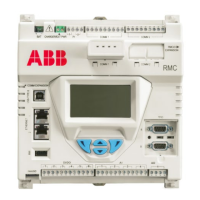16 | RMC-100| 2105552MNAE
Flash.
Factory-supplied registry (MAC address) is stored in 256-byte E2PROM
Parallel 128 x 64 graphic LCD with backlight
Directional button
interface
Dedicated 4 button interface: up, down, left, and right
2 software-configurable RS-232/RS-485/RS-422 hot-swappable serial
ports with 2 communication modules
1 USB 2.0 device interface
3-port 10/100 Mbps Ethernet switch: 2 external ports available for
operator use, 1 internal port (not available for operator use)
1 MMI port backward compatible with XSeriesG4 and XSeriesG5 MMI
6 open/drain outputs, each pin configurable as input or output
4 single-ended channels, 0-30 Vdc or 4-20 mA loop
1 four-wire analog output 4-20 mA (non-isolated, 4-20 mA)
Analog to digital
resolution
24-bit maximum resolution (0.00038% FS)
24-bit nominal resolution (0.0015% FS)
2 dedicated pulse inputs with configurable debounce
(With no debounce: 0 to 20 KHz; with debounce: 0 to 550 Hz)
Configurable up to 4 times per second
2 interfaces for TFIO modules (handled by independent buses)
1 RMC IO expansion interface (available for future use)
1 Type A USB COM expansion (available for future use)
Battery mode: 12 Vdc SLA battery input
External power mode: 9 – 30 Vdc external power source (no battery)
Solar: Nominal 12 Vdc charger controller; solar panel maximum 20
watts (60 ˚C); Maximum 30 Ah SLA battery when using integrated
charger controller
Alternate charger: Power source, 14.5 Vdc to 15.5 Vdc
On/Off supported in combination with two configurable security code
levels
On/Off supported with two configurable security code levels
± 7.5 ppm (parts per million)
2.2.1 Processor and memory
The RMC processor is available in two speeds, 300 MHZ or 720 MHZ, depending on the embedded
software on the purchased system. The RMC standard system runs at 720 MHZ with full application
support. The RMC-LITE system runs at 300 MHZ and supports a lesser number of applications. To
determine the speed of your system or details on the embedded software part numbers, see section
8.4 Update device software. Table 2-4
indicates the memory components of the electronic board.
Table 2-4: Memory components
32-bit flash (flash device software image, configuration and measurement data)
TCXO 32.768 k Oscillator to ensure accurate clocks (+/- 5 ppm accuracy, 5 ppm
drift over time). Standard 50 ppm Oscillator at 25 MHZ to generate the core and
2.2.2 Communication ports
Communication ports provide communication between the RMC and host systems or external devices.
Factory preconfigured ports support typical communication scenarios. The ports support several
available communication protocols.
Ports configured for local communication (direct connection) support either local access from a host
system, or connection to external devices or peripherals (measurement transmitters, additional
automation or control equipment, flow computers or analyzers).
Ports configured for remote communication connect the RMC to a communication network and allow
remote access or management over that network.

